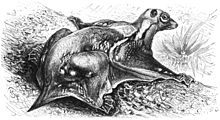Philippines glider
| Philippines glider | ||||||||||||
|---|---|---|---|---|---|---|---|---|---|---|---|---|

Philippines glider ( Cynocephalus volans ), mother and cub |
||||||||||||
| Systematics | ||||||||||||
|
||||||||||||
| Scientific name of the genus | ||||||||||||
| Cynocephalus | ||||||||||||
| Boddaert , 1768 | ||||||||||||
| Scientific name of the species | ||||||||||||
| Cynocephalus volans | ||||||||||||
| ( Linnaeus , 1758) |
The Philippines glider ( Cynocephalus volans ) is a representative of the placental mammals (Eutheria) from the order of the giant gliders (Dermoptera). It lives exclusively on some southern Philippines islands and feeds on plants. Like all representatives of their order, they have a flight membrane between their long limbs with which they can glide.
anatomy

Philippines gliders reach a head-torso length of 33 to 38 centimeters and a "wingspan" of 70 centimeters. The weight is usually 1–1.5 kilograms, with a maximum of 1.75 kilograms. The tail is 22-27 centimeters long.
The species can be distinguished from the very similar Malaysian glider mainly by its coat markings. The dorsal fur is dark in color and often gray and less spotted than the fur of the Malaysian glider. It is used for camouflage on dark tree trunks. The ventral fur is lighter. The dorsal part of the flight membrane is hairy and has a similar color to the surrounding fur, the ventral part of the flight membrane is only very sparsely hairy.
The animals have a large, greyhound-like head (cynocephalus = dog's head), very large eyes and long limbs. The muzzle is blunt.
Occurrence
The Philippines glider is endemic to the southern Philippines. He lives in the rainforests and plantations on the islands of Mindanao , Samar , Siargao , Basilan , Bohol and Leyte .
Way of life
General
Philippines gliders live arboreal and are nocturnal, during the day they sleep in tree hollows. They never go to the ground voluntarily and avoid landing on the ground during their gliding flights. They are loners, but occasionally several animals are in a tree foraging.
nutrition
The diet of the herbivorous Philippines glider consists mainly of leaves, buds and flowers. They mainly eat young leaves, as they can develop their higher nutritional value more easily than with old leaves. Mostly they prefer large trees for foraging. Foraging activities peak just before sunset and a few hours before sunrise.
Reproduction and development
The gestation period of Philippines gliders lasts 60 days, after which a young animal weighing 35 grams and an underdeveloped condition is born. There are seldom two young animals. These are recovered in the hind skin, which forms a pocket when the female slides. During sloth-like climbing and while sleeping, the mother animals serve as a living hammock for the young. The females are often pregnant before they have weaned their current young; in this way they compensate for the low number of young animals per litter.
Natural enemies
Philippines gliders are often hunted by birds of prey, at least in Mindanao they are one of the main prey of the Philippine eagle .
Philippines glider and people
The Philippines glider is often hunted for its fur and meat, which is locally considered a delicacy, and less often for the damage it causes in plantations. Any hunt for them is quite easy, as the animals choose the same or similar routes every night. Until now it is not possible to keep them in captivity.
literature
- TS Kemp: The Origin & Evolution of Mammals . Oxford University Press, Oxford 2005, ISBN 0-19-850761-5 .
- Erwin Kulzer: Dermoptera. Giant gliders, fluttering lemurs, colugos . In: W. Westheide and R. Rieger: Special Zoology. Part 2: vertebrates or skulls . Spektrum Akademischer Verlag, Munich 2004, pp. 574-575, ISBN 3-8274-0307-3 .
- Kathy MacKinnon: giant glider . In: David W. Macdonald (ed.): The great encyclopedia of mammals . Könemann Verlag, Königswinter 2004, pp. 432–433, ISBN 3-8331-1006-6 (German translation of the original edition from 2001).
- Ronald M. Nowak: Walker's Mammals of the World . 2nd Edition. The Johns Hopkins University Press, Baltimore 1999, pp. 250-252, ISBN 0-8018-5789-9 .
- Thomas Schultze-Westrum: The giant gliders. In: Bernhard Grzimek et al. (Ed.): Grzimeks animal life . Vol. 11. Mammals 2 . Kindler Verlag, Zurich 1969, pp. 80–82.
- Don E. Wilson, DeeAnn M. Reeder (Eds.): Mammal Species of the World . 3. Edition. The Johns Hopkins University Press, Baltimore 2005, ISBN 0-8018-8221-4 .
- Erich Thenius and Richard Kraft: Riesengleiter in: Bernhard Grzimek (Ed.): Grzimeks Enzyklopädie, Volume 1: Mammals , pp. 634–639, Kindler 1988, ISBN 3-463-42101-1
Web links
- Cynocephalus volans in the endangered Red List species the IUCN 2006. Posted by: E. McCance, 1996. Retrieved on October 8 of 2006.
Remarks
- ↑ James Ferguson-Lees and David A. Christie: Raptors of the World Helm, London 2001, ISBN 0-7136-8026-1 : pp. 721-722
- ↑ Jayson C. Ibañez, Hector C. Miranda Jr., Gliceria Balaquit-Ibañez, Donald S. Afan, and Robert S. Kennedy: Notes on the Breeding Behavior of a Philippine Eagle Pair at Mount Sinaka, Central Mindanao. The Wilson Bulletin, 115 (3), 2003: pp. 333-336

